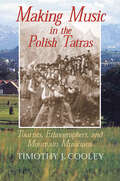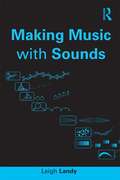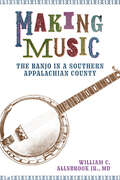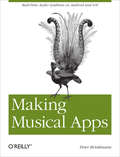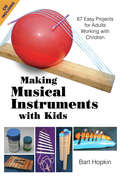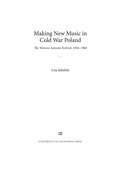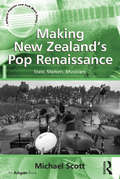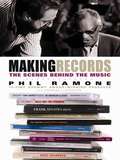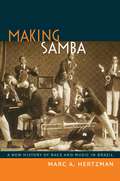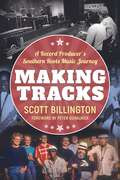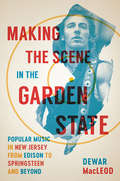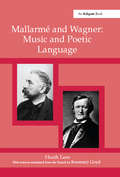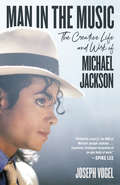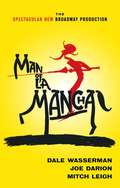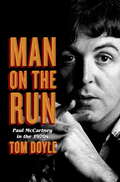- Table View
- List View
Making Music in Los Angeles: Transforming the Popular
by Catherine Parsons SmithIn this social history of music in Los Angeles from the 1880s to 1940, Catherine Parsons Smith ventures into an often neglected period to discover that during America's Progressive Era, L.A. was a center for making music long before it became a major metropolis. She describes the thriving music scene over some sixty years, including opera, concert giving and promotion, and the struggles of individuals who pursued music as an ideal, a career, a trade, a business--or all those things at once.
Making Music in the Polish Tatras: Tourists, Ethnographers, and Mountain Musicians
by Timothy J. CooleyChallenging myths that mountain isolation and ancient folk customs defined the music culture of the Polish Tatras, Timothy J. Cooley shows that intensive contact with tourists and their more academic kin, ethnographers, since the late 19th century helped shape both the ethnic group known as Górale (highlanders) and the music that they perform. Making Music in the Polish Tatras reveals how the historically related practices of tourism and ethnography actually created the very objects of tourist and ethnographic interest in what has become the popular resort region of Zakopane. This lively book introduces readers to Górale musicians, their present-day lives and music making, and how they navigate a regional mountain-defined identity while participating in global music culture. Vivid descriptions of musical performances at weddings, funerals, and festivals and the collaboration of Górale fiddlers with the Jamaican reggae group Twinkle Brothers are framed by discussions of currently influential theories relating to identity and ethnicity and to anthropological and sociological studies of ritual, tourism, festivals, globalism, and globalization. The book includes a 46-track CD illustrating the rich variety of Górale music, including examples of its fusion with Jamaican reggae.
Making Music with Sounds
by Leigh LandyMaking Music with Sounds offers a creative introduction to the art of making sound-based music. It introduces the elements of making compositions with sounds and facilitates creativity in school age children, with the activities primarily for 11-14 year old students. It can also be used by people of all ages becoming acquainted with this music for the first time. Sound-based music is defined as the art form in which the sound, rather than the musical note, is the basic unit and is closely related to electronic music and the sonic arts. The art of sound organisation can be found in a number of forms of music--in film, television, theatre, dance, and new media. Despite this, there are few materials available currently for young people to discover how to make sound-based music. This book offers a programme of development starting from aural awareness, through the discovery and organisation of potential sounds, to the means of generating and manipulating sounds to create sequences and entire works. The book’s holistic pedagogical approach to composition also involves aspects related to musical understanding and appreciation, reinforced by the author’s online pedagogical ElectroAcoustic Resource Site (EARS II).
Making Music: From Tambourines to Rainsticks to Dandelion Trumpets, Walnut Castanets to Shepherd's Pipes to an Abundance of Homemade Drums, Here Is a Joyful, Quirky Assortment of Good Sounds from Found Objects
by John Langstaff Ann Sayre WisemanTune up a milk carton guitar and get ready for a kitchen concerto in the key of utensils major! Ann Sayre Wiseman and John Langstaff offer dozens of ideas that encourage children to unlock their musical creativity using everyday objects. Kids will be inspired as they turn a shower hose into a trumpet or pair zippers and Velcro to make their own percussion ensemble. With ideas for creating and playing more than 70 basic rhythm, string, wind, and keyboard instruments, the musical possibilities are endless.
Making Music: The Banjo in a Southern Appalachian County (American Made Music Series)
by William C. Allsbrook Jr.The banjo has been emblematic of the Southern Appalachian Mountains since the late twentieth century. Making Music: The Banjo in a Southern Appalachian County takes a close look at the instrument and banjo players in Haywood County, North Carolina. Author William C. Allsbrook Jr., MD, presents the oral histories of thirty-two banjo players, all but two of whom were born in Haywood County. These talented musicians recount, in their own words, their earliest memories of music, and of the banjo, as well as the appeal of the banjo. They also discuss learning to play the instrument, including what it “feels like” playing the banjo, many describing occasional “flow states.”In the book, Allsbrook explores an in-home musical folkway that developed along the colonial frontier. By the mid-1800s, frontier expansion had ceased in Haywood County due to geographic barriers, but the in-home musical tradition, including the banjo, survived in largely isolated areas. Vestiges of that tradition remain to this day, although the region has undergone significant changes over the lifetimes of the musicians interviewed. As a result, the survival of the in-home tradition is not guaranteed. Readers are invited into the private lives of the banjo players and asked to consider the future of the banjo in the face of contemporary trends. The future will be shaped by how this remarkable mountain culture continues to adapt to these challenges. Still, this thriving community of banjo players represents the vibrant legacy of the banjo in Haywood County and the persistence of tradition in the twenty-first century.
Making Musical Apps: Real-time audio synthesis on Android and iOS
by Peter BrinkmannWant to turn your mobile device into a musical instrument? Or equip your game with interactive audio, rather than canned samples? You can do it with Pure Data (Pd), an open source visual programming environment that lets you manipulate digital audio in real time. This concise book shows you how to use Pd—with help from the libpd library—as an easily embeddable and widely portable sound engine.Whether you’re an audio developer looking to create musical apps with sophisticated audio capabilities, or an application developer ready to enhance mobile games with real-time procedural audio, Making Musical Apps introduces you to Pd and libpd, and provides hands-on instructions for creating musical apps for Android and iOS.Get a crash course in Pd, and discover how to generate and control soundsLearn how to create and deploy algorithmic compositions that react to a user’s activity and environmentUse Java or Objective-C to integrate Pd and libpd into mobile appsLearn the steps necessary to build libpd-based apps for Android and iOS
Making Musical Instruments with Kids: 67 Easy Projects for Adults Working with Children
by Bart HopkinWritten for adults, this hands-on guide demonstrates how to make easy musical instruments with children. Detailed instructions are included for making more than 60 unique instruments that are suitable for children as young as five years. Serving as a resource in the classroom or home, this manual is extensively illustrated with drawings and photographs along with an audio sample of the instruments in lively solo and ensemble pieces.
Making New Music in Cold War Poland: The Warsaw Autumn Festival, 1956-1968
by Lisa JakelskiMaking New Music in Cold War Poland presents a social analysis of new music dissemination at the Warsaw Autumn International Festival of Contemporary Music, one of the most important venues for East-West cultural contact during the Cold War. In this incisive study, Lisa Jakelski examines the festival's institutional organization, negotiations among its various actors, and its reception in Poland, while also considering the festival's worldwide ramifications, particularly the ways that it contributed to the cross-border movement of ideas, objects, and people (including composers, performers, official festival guests, and tourists). This book explores social interactions within institutional frameworks and how these interactions shaped the practices, values, and concepts associated with new music.
Making New Zealand's Pop Renaissance: State, Markets, Musicians (Ashgate Popular and Folk Music Series)
by Michael ScottSince the early 2000s New Zealand has undergone a pop renaissance. Domestic artists' sales, airplay and concert attendance have all grown dramatically while new avenues for 'kiwi' pop exports emerged. Concurrent with these trends was a new collective sentiment that embraced and celebrated domestic musicians. In Making New Zealand's Pop Renaissance, Michael Scott argues that this revival arose from state policies and shows how the state built market opportunities for popular musicians through public-private partnerships and organizational affinity with existing music industry institutions. New Zealand offers an instructive case for the ways in which 'after neo-liberal' states steer and co-ordinate popular culture into market exchange by incentivizing cultural production. Scott highlights how these music policies were intended to address various economic and social problems. Arriving with the creative industries' discourse and policy making, politicians claimed these expanded popular music supports would facilitate sustainable employment and a sense of national identity. Yet popular music as economic and social policy presents a paradox: the music industry generates commercial failure and thus requires a large unattached pool of potential talent. Considering this feature, Scott analyses how state programs induced an informal economy of proto-pop production aimed at accessing competitive state funding while simultaneously encouraging musicians to adopt entrepreneurial subjectivities. In doing so he argues New Zealand's music policies are a form of social policy that unintentionally deploy hierarchical structures to foster social inclusion amongst growing numbers of creative workers.
Making Records: The Scenes Behind the Music
by Phil RamoneSinatra. Streisand. Dylan. Pavarotti. McCartney. Sting. Madonna. What do these musicians have in common besides their super-stardom? They have all worked with legendary music producer Phil Ramone.For almost five decades, Phil Ramone has been a force in the music industry. He has produced records and collaborated with almost every major talent in the business. There is a craft to making records, and Phil has spent his life mastering it. For the first time ever, he shares the secrets of his trade.Making Records is a fascinating look "behind the glass" of a recording studio. From Phil's exhilarating early days recording jazz and commercial jingles at A&R, to his first studio, and eventual legendary producer status, Phil allows you to sit in on the sessions that created some of the most memorable music of the 20th century--including Frank Sinatra's Duets album, Bob Dylan's Blood on the Tracks, Ray Charles's Genius Loves Company and Paul Simon's Still Crazy After All These Years.In addition to being a ringside seat for contemporary popular music history, Making Records is an unprecedented tutorial on the magic behind what music producers and engineers do. In these pages, Phil offers a rare peek inside the way music is made . . . illuminating the creative thought processes behind some of the most influential sessions in music history.This is a book about the art that is making records--the way it began, the way it is now, and everything in between.
Making Samba: A New History of Race and Music in Brazil
by Hertzman Marc A.In November 1916, a young Afro-Brazilian musician named Donga registered sheet music for the song "Pelo telefone" ("On the Telephone") at the National Library in Rio de Janeiro. This apparently simple act--claiming ownership of a musical composition--set in motion a series of events that would shake Brazil's cultural landscape. Before the debut of "Pelo telephone," samba was a somewhat obscure term, but by the late 1920s, the wildly popular song had helped to make it synonymous with Brazilian national music. The success of "Pelo telephone" embroiled Donga in controversy. A group of musicians claimed that he had stolen their work, and a prominent journalist accused him of selling out his people in pursuit of profit and fame. Within this single episode are many of the concerns that animate Making Samba, including intellectual property claims, the Brazilian state, popular music, race, gender, national identity, and the history of Afro-Brazilians in Rio de Janeiro. By tracing the careers of Rio's pioneering black musicians from the late nineteenth century until the 1970s, Marc A. Hertzman revises the histories of samba and of Brazilian national culture.
Making Scenes: Reggae, Punk, and Death Metal in 1990s Bali
by Emma BaulchIn 1996, Emma Baulch went to live in Bali to do research on youth culture. Her chats with young people led her to an enormously popular regular outdoor show dominated by local reggae, punk, and death metal bands. In this rich ethnography, she takes readers inside each scene: hanging out in the death metal scene among unemployed university graduates clad in black T-shirts and ragged jeans; in the punk scene among young men sporting mohawks, leather jackets, and hefty jackboots; and among the remnants of the local reggae scene in Kuta Beach, the island's most renowned tourist area. Baulch tracks how each music scene arrived and grew in Bali, looking at such influences as the global extreme metal underground, MTV Asia, and the internationalization of Indonesia's music industry. Making Scenes is an exploration of the subtle politics of identity that took place within and among these scenes throughout the course of the 1990s. Participants in the different scenes often explained their interest in death metal, punk, or reggae in relation to broader ideas about what it meant to be Balinese, which reflected views about Bali's tourism industry and the cultural dominance of Jakarta, Indonesia's capital and largest city. Through dance, dress, claims to public spaces, and onstage performances, participants and enthusiasts reworked "Balinese-ness" by synthesizing global media, ideas of national belonging, and local identity politics. Making Scenes chronicles the creation of subcultures at a historical moment when media globalization and the gradual demise of the authoritarian Suharto regime coincided with revitalized, essentialist formulations of the Balinese self.
Making Tracks: A Record Producer’s Southern Roots Music Journey (American Made Music Series)
by Scott BillingtonFrom the 1980s through the early 2000s, a golden era for southern roots music, producer and three-time Grammy winner Scott Billington recorded many of the period’s most iconic artists. Working primarily in Louisiana for Boston-based Rounder Records, Billington produced such giants as Irma Thomas, Charlie Rich, Buckwheat Zydeco, Johnny Adams, Bobby Rush, Ruth Brown, Beau Jocque, and Solomon Burke. The loving and sometimes irreverent profiles in Making Tracks reveal the triumphs and frustrations of the recording process, and that obsessive quest to capture a transcendent performance. Billington's long working relationships with the artists give him perspective to present them in their complexity—foibles, failures, and fabled feats—while providing a vivid look at the environs in which their music thrived. He tells about Boozoo Chavis’s early days as a musician, jockey, and bartender at his mother’s quarter horse track, and Ruth Brown’s reign as the most popular star in rhythm and blues, when the challenge of traveling on the “chitlin’ circuit” proved the antithesis of the glamour she exuded on stage. In addition, Making Tracks provides a widely accessible study in the craft of recording. Details about the technology and psychology behind the sessions abound. Billington demonstrates varying ways of achieving the mutual goal of a great record. He also introduces the supporting cast of songwriters, musicians, and engineers crucial to the magic in each recording session. Making Tracks sings unforgettably like a "from the vault" discovery.
Making and Marketing Music: The Musician's Guide to Financing, Distributing, and Promoting Albums
by Jodi SummersThis industry-savvy guide will help musicians of all levels make the album that best complements their skills and meets their career objectives. Revealed here are the who, what, where, when and how of album making, and the tools to sell and prosper in the business. Included are interviews with P. Diddy, Ozzy Osbourne, and members of Linkin Park, and other top industry professionals.Allworth Press, an imprint of Skyhorse Publishing, publishes a broad range of books on the visual and performing arts, with emphasis on the business of art. Our titles cover subjects such as graphic design, theater, branding, fine art, photography, interior design, writing, acting, film, how to start careers, business and legal forms, business practices, and more. While we don't aspire to publish a New York Times bestseller or a national bestseller, we are deeply committed to quality books that help creative professionals succeed and thrive. We often publish in areas overlooked by other publishers and welcome the author whose expertise can help our audience of readers.
Making the Great Book of Songs: Compilation and the Author's Craft in Abû I-Faraj al-Isbahânî's Kitâb al-aghânî (Routledge Studies in Middle Eastern Literatures)
by Hilary KilpatrickThis is the first systematic literary study of one of the masterpieces of classical Arabic literature, the fourth/tenth century Kitâb al-aghânî (The Book of Songs) by Abû I-Faraj al-Isbahânî. Until now the twenty-four volume Book of Songs has been regarded as a rather chaotic but priceless mine of information about classical Arabic music, literature and culture. This book approaches it as a work of literature in its own right, with its own internal logic and coherence. The study also consistently integrates the musical component into the analysis and proposes a reading of the work in which individual anecdotes and poems are related to the wider context, enhancing their meaning.
Making the March King: John Philip Sousa's Washington Years, 1854-1893
by Patrick WarfieldJohn Philip Sousa's mature career as the indomitable leader of his own touring band is well known, but the years leading up to his emergence as a celebrity have escaped serious attention. In this revealing biography, Patrick Warfield explains the making of the March King by documenting Sousa's early life and career. Covering the period 1854 to 1893, this study focuses on the community and training that created Sousa, exploring the musical life of late nineteenth-century Washington, D.C., and Philadelphia as a context for Sousa's development. Warfield examines Sousa's wide-ranging experience composing, conducting, and performing in the theater, opera house, concert hall, and salons, as well as his leadership of the United States Marine Band and the later Sousa Band, early twentieth-century America's most famous and successful ensemble. Sousa composed not only marches during this period but also parlor, minstrel, and art songs; parade, concert, and medley marches; schottisches, waltzes, and polkas; and incidental music, operettas, and descriptive pieces. Warfield's examination of Sousa's output reveals a versatile composer much broader in stylistic range than the bandmaster extraordinaire remembered as the March King. Warfield presents the story of Sousa as a self-made business success, a gifted performer and composer who deftly capitalized on his talents to create one of the most entertaining, enduring figures in American music.
Making the Scene in the Garden State: Popular Music in New Jersey from Edison to Springsteen and Beyond
by Dewar MacLeodMaking the Scene in the Garden State explores New Jersey’s rich musical heritage through stories about the musicians, listeners and fans who came together to create sounds from across the American popular music spectrum. The book includes chapters on the beginnings of musical recording in Thomas Edison’s factories in West Orange; early recording and the invention of the Victrola at Victor Records’ Camden complex; Rudy Van Gelder’s recording studios (for Blue Note, Prestige, and other jazz labels) in Hackensack and Englewood Cliffs; Zacherley and the afterschool dance television show Disc-o-Teen, broadcast from Newark in the 1960s; Bruce Springsteen’s early years on the Jersey Shore at the Upstage Club in Asbury Park; and, the 1980s indie rock scene centered at Maxwell’s in Hoboken. Concluding with a foray into the thriving local music scenes of today, the book examines the sounds, sights and textures of the locales where New Jerseyans have gathered to rock, bop, and boogie.
Malayan Emergency: Triumph of the Running Dogs, 1948–1960 (Cold War, 1945–1991)
by Gerry van TonderWhen the world held its breath It is 25 years since the end of the Cold War, now a generation old. It began over 75 years ago, in 1944long before the last shots of the Second World War had echoed across the wastelands of Eastern Europewith the brutal Greek Civil War. The battle lines are no longer drawn, but they linger on, unwittingly or not, in conflict zones such as Iraq, Somalia and Ukraine. In an era of mass-produced AK-47s and ICBMs, one such flashpoint was Malaya By the time of the 1942 Japanese occupation of the Malay Peninsula and Singapore, the Malayan Communist Party (MCP) had already been fomenting merdeka independence from Britain. The Japanese conquerors, however, were also the loathsome enemies of the MCPs ideological brothers in China. An alliance of convenience with the British was the outcome. Britain armed and trained the MCPs military wing, the Malayan Peoples Anti-Japanese Army (MPAJA), to essentially wage jungle guerrilla warfare against Japanese occupying forces. With the cessation of hostilities, anti-Japanese became anti-British, and, using the same weapons and training fortuitously provided by the British army during the war, the MCP launched a guerrilla war of insurgency.Malaya was of significant strategic and economic importance to Britain. In the face of an emerging communist regime in China, a British presence in Southeast Asia was imperative. Equally, rubber and tin, largely produced in Malaya by British expatriates, were important inputs for British industry. Typically, the insurgents, dubbed Communist Terrorists, or simply CTs, went about attacking soft targets in remote areas: the rubber plantations and tin mines. In conjunction with this, was the implementation of Maos dictate of subverting the rural, largely peasant, population to the cause. Twelve years of counterinsurgency operations ensued, as a wide range of British forces were joined in the conflict by ground, air and sea units from Australia, New Zealand, Southern and Northern Rhodesia, Fiji and Nyasaland.
Mallarmé Wagner: Music and Poetic Language
by Heath LeesThis book challenges and replaces the existing view of Mallarm mission to 're-possess' music on behalf of poetic language. Traditionally, this view focused on only the last fifteen years of the poet's life, and sprang from a belief in Mallarm 'sudden awakening' to music during an all-Wagner concert in Paris, in 1885. Professor Heath Lees shows that Mallarm early knowledge and experience of music was much greater than commentators have realized, and that the French poet actually began his writing career with the explicit aim of making music's performance-language of 'effect' the ground of his poetic expression. Integral to the argument is Mallarm reaction to the work and ideas of Richard Wagner, whose impact on France came in two waves: the first broke during the tempestuous 1860s days of the Paris Tannhäuser, while the second arrived in the mid-1880s, and gave birth to the Revue Wagn enne. In refuting the critical literature that focuses on only the second of these waves, Lees shows that Mallarm xhibited a highly informed Wagnerian background during the first wave, and that his grasp of the composer's gestural motives and flexible musical prose led him towards a new kind of self-expressive, gestural rhythm that aimed musically to reinvent poetic language. In support of this, the book examines closely what Wagner 'really' said in the prose works that were becoming known in Paris by the 1860s, in particular, Wagner's important French text, the Lettre sur la musique. It also re-examines Baudelaire's classic Wagner-brochure, and reveals its author's surprisingly firm grasp of Wagner's musico-poetic fusion. In musically informed commentary, Professor Lees surveys the four decades of success and failure that resulted from Mallarm repeated attempts to draw out the musical gestures and resonances of words alone. In the process, he throws new light on many of Mallarm best-known texts, hitherto judged 'difficult' by those who have failed to
Mama Don't Allow
by Thacher HurdTOO LOUD! WHAT A RACKET! UNBEARABLE! Why don't you practice outside, dear? Not only Miles' parents, but the whole neighborhood has had enough of Miles' new saxophone! However, when Miles teams up with three other musicians to form the Swamp Band, their music suddenly gets a startlingly different reception. "We love that Swamp Band music!" yell the sharp-toothed, long-tailed, yellow-eyed alligators. "We like it LOUD! Come and play for the Alligator Ball." The Swamp Band is delighted . . . but little do they know what is in store for them after their first all-night jamboree. Every noise-loving child (and noise-hating parent) will revel in Thacher Hurd's funny, jazzy tale inspired by the traditional American song "Mama Don't Allow." Presch-3
Mama Mable's All-Gal Big Band Jazz Extravaganza!
by Annie SiegDebut author-illustrator Annie Sieg takes young readers on an inspiring trip to the music halls of the 1940s, when groups of young female musicians broke racial and gender barriers--and forever changed the face of jazz. Everyone knows about Rosie the Riveter, the icon for working women during World War II. Now prepare to meet a group of young women who did the same for music! From saxophonists and drummers to trumpeters, pianists, trombonists, and singers, talented young women across the country picked up their instruments--and picked up the spirits of an entire nation--during the dark days of World War II. Together they formed racially integrated female bands and transformed the look and sound of jazz, taking important strides for all women in the world of music. Debut author-illustrator Annie Sieg shines a spotlight on the young women who epitomized the sound and spirit of jazz of the era, while opening young readers' eyes and ears to the role of women then and now in music.
Man in the Music: The Creative Life and Work of Michael Jackson
by Joseph VogelFor half a century, Michael Jackson&’s music has been an indelible part of our cultural consciousness. Landmark albums such as Off the Wall and Thriller shattered records, broke racial barriers, amassed awards, and set a new standard for popular music. While his songs continue to be played in nearly every corner of the world, however, they have rarely been given serious critical attention. The first book dedicated solely to exploring his creative work, Man in the Music guides us through an unparalleled analysis of Jackson&’s recordings, album by album, from his trailblazing work with Quincy Jones to his later collaborations with Teddy Riley, Jimmy Jam, Terry Lewis, and Rodney Jerkins. Drawing on rare archival material and on dozens of original interviews with the collaborators, engineers, producers, and songwriters who helped bring the artist&’s music into the world, Jackson expert and acclaimed cultural critic Joseph Vogel reveals the inspirations, demos, studio sessions, technological advances, setbacks and breakthroughs, failures and triumphs, that gave rise to an immortal body of work.
Man of Constant Sorrow: My Life and Times
by Ralph StanleyA legend looks back on his six decades in music. <P> Ralph Stanley was born in 1927 in a corner of Virginia known as Big Spraddle Creek, a place where music echoed from the ridge tops, was belted out by workers in the fields, and resonated in the one-room country church where Ralph first found his voice. For his eleventh birthday, Ralph was given five dollars, and had to chose between buying a sow or a banjo. He chose the banjo, which his mother taught him to play in the clawhammer style. In 1946, he combined his banjo with his brother Carter's guitar, and the two blended their voices into one as the Stanley Brothers. For twenty years the Stanleys chased the dream through good times and hard times, until the hard times caught up to Carter and he succumbed to liver disease at age 41. In the four decades since his brother's passing, Ralph has brought his music from the hills and hollows of southwest Virginia to the wide world. <P> Now in his eighties and still touring, Ralph has at last grown into his voice and is ready to tell his story. In Man of Constant Sorrow, Ralph looks back on his career in what most call bluegrass but what he prefers to call "old time mountain music." He recounts the creation of hundreds of classic tracks, including "White Dove," "Rank Stranger," and his signature song, "Man of Constant Sorrow." He tells tales from a life spent on road with his band the Clinch Mountain Boys, explains his distinctive "Stanley style" of banjo-playing, crosses paths with everyone from Bill Monroe to Bob Dylan, and reflects on his late-career resurgence sparked by an unlikely Grammy win in 2002 for his song "O Death." He also raises a dirge for Appalachia, his mountain home that is quickly disappearing. <P> Harmonized with equal measures of tragedy and triumph, Man of Constant Sorrow is the stirring testament of a giant of American music.
Man of La Mancha: A Musical Play
by Dale WassermanThis is a powerful story of a man, disillusioned with everyday life, who decides to become a Knight Errant and go out forth into the world righting all wrongs.
Man on the Run
by Tom DoyleAn illuminating look at the most tumultuous decade in the life of a rock icon--the only McCartney biography in decades based on firsthand interviews with the ex-Beatle himself. As the 1970s began, the Beatles ended, leaving Paul McCartney to face the new decade with only his wife Linda by his side. Holed up at his farmhouse in Scotland, he sank into a deep depression. To outsiders, McCartney seemed like a man adrift--intimidated by his own fame, paralyzed by the choices that lay before him, cut loose from his musical moorings. But what appeared to be the sad finale of a glorious career was just the start of a remarkable second act. The product of a long series of one-on-one interviews between McCartney and Scottish rock journalist Tom Doyle, Man on the Run chronicles Paul McCartney's decadelong effort to escape the shadow of his past, outrace his critics, and defy the expectations of his fans. From the bitter and painful breakup of the Beatles to the sobering wake-up call of John Lennon's murder, this is a deeply revealing look at a sometimes frightening, often exhilarating period in the life of the world's most famous rock star. Sensing that he had nowhere to go but up, Paul McCartney started over from scratch. With emotional--and musical--backing from Linda, he released eccentric solo albums and embarked on a nomadic hippie lifestyle. He formed a new band, Wings, which first took flight on a ramshackle tour of British university towns and eventually returned Paul to the summit of arena rock superstardom. In Man on the Run, Doyle follows McCartney inside the recording sessions for Wings' classic album Band on the Run--and provides context for some of the baffling misfires in his discography. Doyle tracks the dizzying highs and exasperating lows of a life lived in the public spotlight: the richly excessive world tours, the Japanese drug bust that nearly ended McCartney's career, his bitter public feuds with his erstwhile Beatle bandmates, and the aftermath of an infamous drug-and-alcohol-fueled jam session where McCartney helped reconcile the estranged John Lennon and Yoko Ono. For Paul McCartney, the 1970s were a wild ride with some dark turns. Set against the backdrop of a turbulent decade, Man on the Run casts the "sunny Beatle" in an entirely new light.Advance praise for Man on the Run "Tom Doyle's Man on the Run is a riveting dispatch from the seventies. Paul McCartney's story is told with clever pacing, unflinching honesty, and a gripping narrative drive that benefits from his intimate participation via interviews and support. This is simply one of the best rock biographies anyone has written."--Stephen Davis, bestselling author of Hammer of the Gods and Watch You Bleed "Man on the Run is simply brimming with enough fascinating facts and expertly rendered anecdotes to make even the most ardent McCartney follower do an abrupt about-face. Maybe I'm amazed? You better believe it."--Kent Hartman, music industry executive and bestselling author of The Wrecking Crew "What happens when you can do anything you like but nothing will ever be good enough? Doyle makes sense of a stoned shaggy dog story that has none of the narrative neatness of the Beatles' rise and fall."--The Guardian (U.K.), "Music Books of the Year" "[Doyle] offers a level-headed and admirably nonjudgmental portrait of a turbulent ten years, punctuated by great music, creative misfires and frequent run-ins with the law."--Sunday Express (U.K.)From the Hardcover edition.

